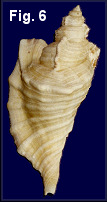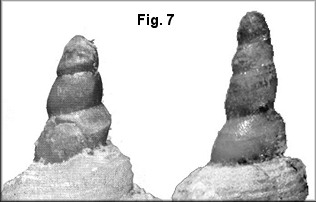|
Good Work Ultimately Reaps Its (His) Reward By Harry G. Lee |
|
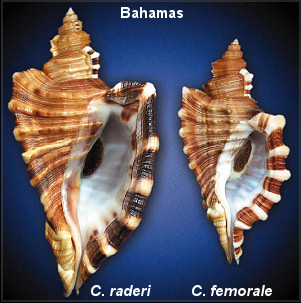 Recently Jim Miller (2003) shelled the island
of Eleuthera, Bahamas which he shared through a lavishly-illustrated
report for American Conchologist. Probably the most
noteworthy find on the trip was live 8.25 inch Cymatium raderi
(D'Attilio and Myers, 1984) taken while at snorkeling depth
(figured to the left of a 160 mm C. femorale from Grand
Bahama Is. opposite this paragraph). He
wrote: "Naturally, like everyone else, I thought of C. raderi
as a species found much farther south, and all the specimens I have
ever seen have been collected in Brazil." Jim's observation
allows us to look closely at the taxonomy and underappreciated
biologic potential of this snail and its relatives. Recently Jim Miller (2003) shelled the island
of Eleuthera, Bahamas which he shared through a lavishly-illustrated
report for American Conchologist. Probably the most
noteworthy find on the trip was live 8.25 inch Cymatium raderi
(D'Attilio and Myers, 1984) taken while at snorkeling depth
(figured to the left of a 160 mm C. femorale from Grand
Bahama Is. opposite this paragraph). He
wrote: "Naturally, like everyone else, I thought of C. raderi
as a species found much farther south, and all the specimens I have
ever seen have been collected in Brazil." Jim's observation
allows us to look closely at the taxonomy and underappreciated
biologic potential of this snail and its relatives.In the original description of C. raderi, D'Attilio and Myers (1984) identified specimens from Honduras (type locality), "Dry Tortugas, collected by shrimpers" and Tobago as examples of the new taxon. Veteran shellers cast a skeptical eye when the "shrimp fishery" and "Dry Tortugas" are spoken together - a classic in conchological apocrypha. On the other hand, the authors also cited the specimen depicted in pl. 129, fig. 1 of Clench and Turner (1957), from Great Abaco, BAHAMAS and captioned "C. femorale (Linnaeus, 1758)" as C. raderi; they didn't comment on fig. 2, a specimen from Bear Cut, near Miami Florida, collected by Robert Work. Turn the clock back thirty years and you might find now-retired University of Miami marine biologist Bob Work (pers. comm.) working the shallows between Virginia Key and Key Biscayne near the spot where the Institution's Rosenstiel School of Marine and Atmospheric Science (then just the Marine Lab) was transplanted from Coral Gables in the summer of 1957. I have first-hand knowledge of that very scenario because I was there for the both collecting and the move, as a "high school summer fellow" at the University, and I frequently associated with Mr. Work. To be fair to the facts, I must admit my role was more idolatrous sycophant/common laborer than scientific colleague. Anyway, Bob still recalls collecting "a few" Cymatium raderi in Bear Cut from 1950 to 1960, when they were "not uncommon.... from Thalassia on clean sand....very shallow." He thought the truncated and incurved termination of the varices, weaker spiral cords, dentate aperture, reduced intervarical nodes, and the larger maximal size of this taxon set it apart from the shells of C. femorale, with which it occurred. As Bill Clench was preparing his Cymatiidae (now Ranellidae) monograph, Bob sent some Bear Cut specimens, which he had then determined to be different from C. femorale, along with some typical specimens of the latter, to the Museum of Comparative Zoology (Harvard U.). There Dr. Clench identified all the shells as C. femorale and incorporated not only Bob's Bear Cut record but illustrated one of the "different" specimens (Clench and Turner, 1957; pl. 129, fig. 2) as C. femorale. Now it is apparent that the figured shell is C. raderi not C. femorale. |
|
|
|
|
|
|
|
|
Our figures depict a large C. raderi (146
mm high; 82 mm wide;
dorsal view: fig 1; ventral
view: fig. 2) and two smaller shells (fig. 3
ventral: C. raderi, 111 mm by 58 mm on R; C. femorale,
112 mm long, L) and (fig. 4
dorsal: C. raderi on L; C. femorale R). All three
specimens were collected between 1950 and 1960 by Mr. Work and are
in his personal collection.
|
|
|
|
|
|
Given
the renowned longevity of triton (and most Tonnoidea) larvae, as
reflected in the multispiral protoconch of "C. femorale"
(fig. 7; L: from Clench and Turner, 1947; pl. 129, fig. 3; R:
Redfern, 2001 pl. 30, fig. 256B adjusted to the same
magnification),** one would expect them to have an advantage when it
comes to larval dispersal and, consequently, zoogeographic range.
There are dozens of cases in point to confirm this cosmopolitan
tendency. "Now" C. raderi, ranging from southeast
Florida and the Bahamas to Brazil (the latter added by Henning and Hemmen,
1993), is only approaching the norm for New World Cymatium.
Even though we know that seven of our ten
Jacksonville ranellid species are well-known to be circumtropical
and two others amphi-Atlantic, triton ranges continue to be
"extended" on a frequent basis as evidenced by the reports by
Gibson-Smith et al. (1970) ["west African" C. trigonum
Venezuela], Kalafut (1988) ["west African" C. tranquebaricum
Florida Keys], and Piech (1993) ["Indo- west Pacific" taxa: C.
gallinago Brazil; C. mundum Gulf of Mexico and
southeast Florida; C. pfeifferianum Gulf of Mexico and
Brazil, and C. vespaceum Honduras and Florida Keys]
to
name six species not (yet) found locally. Now it's easy to see that new "extended" records are popping up and that tritons have prodigious powers of dispersal, but why do these finds appear to be so novel? There are probably two or three reasons: (1) Tritons are never particularly abundant where they live. Feeding on slow-growing echinoderms, many species cannot achieve robust enough population densities to allow easy collecting. This is likely the case in Abaco (Redfern, 2001). (2) As evidenced by Bob's travail, some tritons are hard to identify and may be concealed by an erroneous label. (3) International maritime commerce may facilitate veliger traffic (bilge stowaways). Footnote: Cymatium (C.) etcheversi Macsotay and Villarroel, 2001 (pp. 65-66; pl. 6, figs. 14,15), named from the Margarita Platform off Venezuela, is clearly C. raderi. The authors failed to compare the two taxa, but they did acknowledge their new species occurs in Jamaica and South Florida based on illustrations in Humfrey (1975: pl. 13, fig. 6) and M. Smith (1951: pl. 42, fig. 3). Interestingly, these figures actually depict C. femorale! |
|
|
Camp, D. K., W. G. Lyons, and T. H. Perkins, 1998. Checklists of
selected shallow-water marine invertebrates of Florida. Florida
|
|
| Clench, W. J. and R. D. Turner, 1957. The family Cymatiidae in the western Atlantic. Johnsonia 3(36): 189-244. Dec. 20. | |
|
Gibson-Smith, J., W. Gibson-Smith, and F. Gibson-Smith, 1970.
Another species of the genus Cymatium swims the Atlantic
Boletin
|
|
|
Henning, T. and J. Hemmen, 1993. Ranellidae and Personidae of the world. Verlag Christa Hemmen, Wiesbaden, pp. 1-263, incl. 30 pls. |
|
| Humfrey, M., 1975. Sea shells of the West Indies: a guide to the marine mollusks of the Caribbean. Taplinger Publishing Co., New York, pp. 1-351 + 32 pls. | |
| Kalafut. T., 1988. An occurrence of Cymatium tranquebaricum in Florida. American Conchologist 16(2): 17. June. | |
| Miller, J., 2003. Eleuthera 2003. American Conchologist 31(2): 10-14. June. | |
| Macsotay, O. and R. Campos Villarroel, 2001. Moluscos representativos de la plataforma de Margarita -Venezuela - descipcion de 24 especies nuevas. Rivolta, Valencia, Venezuela iii + 1-280 incl. 32 pls. July. | |
| Piech, B. J., 1993. New records for ranellid gastropods in the western Atlantic (Ranellidae: Cymatiinae). The Veliger 36(1): 88-91. Jan. 4. | |
| Redfern, C., 2001. Bahamian seashells a thousand species from Abaco, Bahamas. Bahamianseashells.com, Inc., Boca Raton, pp. 1-280 + ix + 120 pls. | |
|
Rosenberg, G., 1995 et seq. Malacolog 2.0: A searchable database for research on the systematics, biogeography, and diversity of Western Atlantic marine mollusks. June 28, 2005. |
|
| Smith, M., 1951. East Coast Marine Shells fourth edition. Edwards Bros., Ann Arbor. vii + 1-314 incl. 77 plates. | |
|
Turgeon, D. D., J. F. Quinn, Jr., A. E. Bogan, E. V. Coan, F. G.
Hochberg, W. G. Lyons, P. M. Mikkelsen, R. J. Neves, C. F. E.
|
|
| Work, R., 2005. Personal communication April 19. | |
| ** these protoconchs appear to differ significantly. Is it possible that there are two different species involved? | |
| Acknowledgements: The author offers his gratitude to Bob Work (South Miami) for his cooperation, Bill Frank for major technical assistance, Jim Miller (Tallahassee) for information on, and images of, the Bahamas and Jamaica specimens as well as prodigious image enhancement, Colin Redfern (Boca Raton) for creating figure 7, which includes his original image, and Edgar Rincon (Venezuela), who photographed Mr. Work's specimens. | |
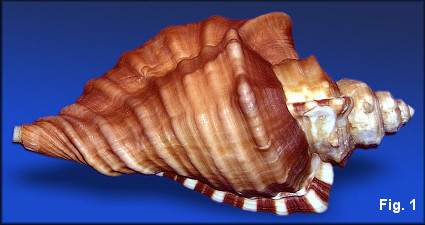
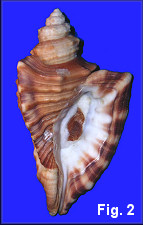
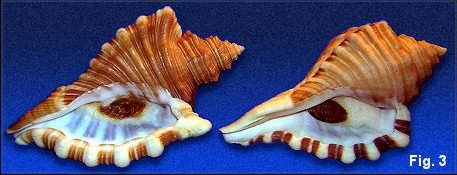
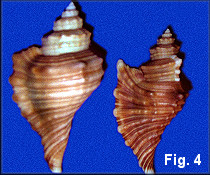
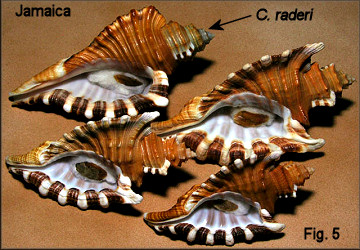 Bob's observation (and tenacity) leaves little doubt that
C. raderi isn't just "extending" its range; it's been in Florida
and the Bahamas for over a half century (and probably eons).
Although the regional works [Henning and Hemmen (1993), Camp et
al.(1998), Turgeon, Quinn et al. (1998), Redfern, 2001, and
Rosenberg (June 28, 2005)]
don't reflect that fact for one explanation or another, there is
every reason to think that these "new" observations are accurate -
and even expected (see below).
Bob's observation (and tenacity) leaves little doubt that
C. raderi isn't just "extending" its range; it's been in Florida
and the Bahamas for over a half century (and probably eons).
Although the regional works [Henning and Hemmen (1993), Camp et
al.(1998), Turgeon, Quinn et al. (1998), Redfern, 2001, and
Rosenberg (June 28, 2005)]
don't reflect that fact for one explanation or another, there is
every reason to think that these "new" observations are accurate -
and even expected (see below).